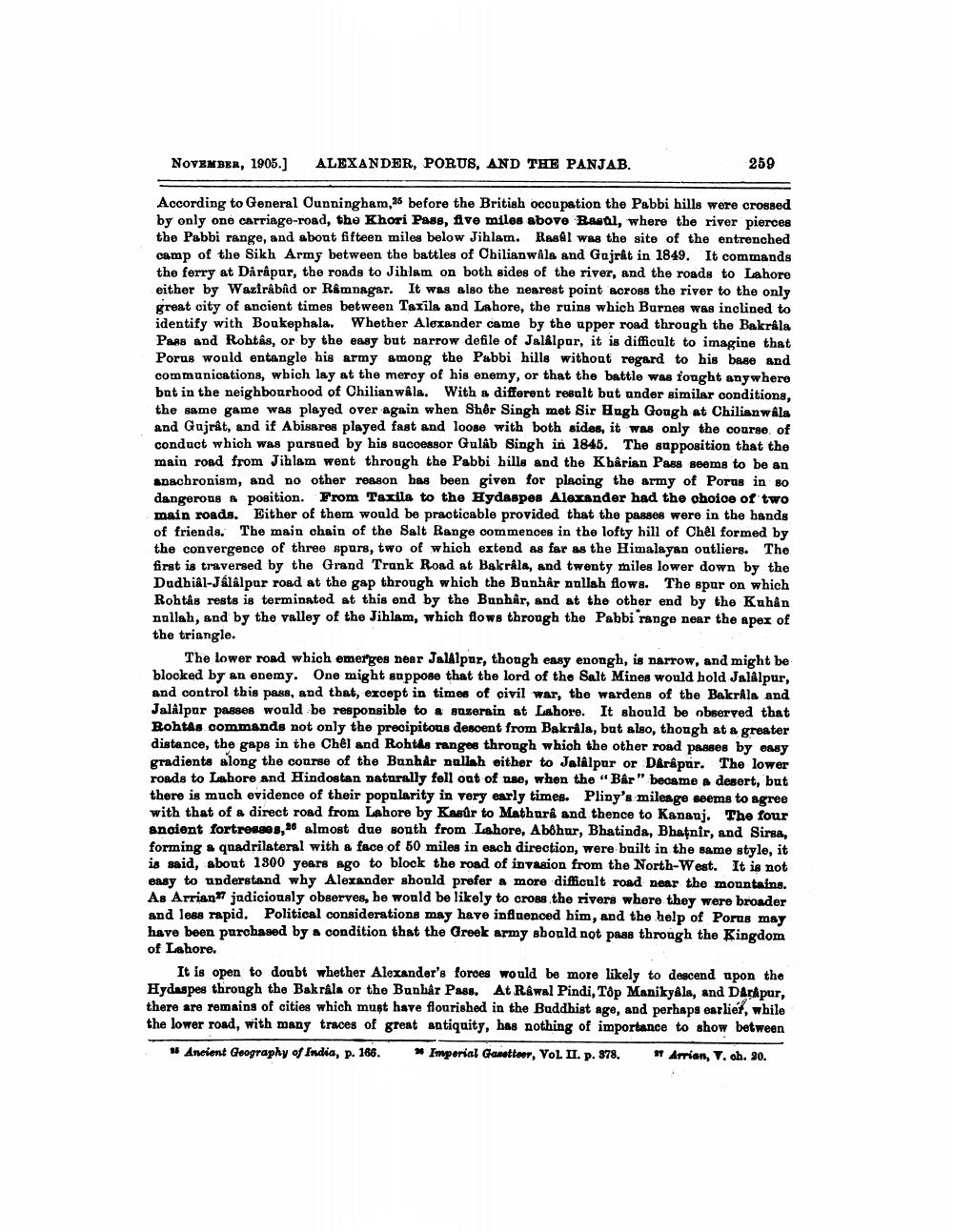________________
NOVEMBER, 1905.)
ALEXANDER, PORUS, AND THE PANJAB.
259
According to General Cunningham, 25 before the British occupation the Pabbi hills were crossed by only one carriage-road, the Khori Pass, five miles above Baal, where the river pierces the Pabbi range, and about fifteen miles below Jihlam. Rasel was the site of the entrenched camp of the Sikh Army between the battles of Chilianwala and Gajrât in 1849. It commands the ferry at Dåråpur, the roads to Jihlam on both sides of the river, and the roads to Lahore either by Wazirabad or Râmnagar. It was also the nearest point across the river to the only great city of ancient times between Taxila and Lahore, the ruins which Burnes was inclined to identify with Boukephala. Whether Alexander came by the upper road through the Bakrála Paas and Rohtas, or by the easy but narrow defile of Jalálpar, it is difficult to imagine that Porus would entangle his army among the Pabbi hills without regard to his base and communications, which lay at the mercy of his enemy, or that the battle was fought anywhere but in the neighbourhood of Chilianwâla. With a different result but ander similar conditions, the same game was played over again when Sher Singh met Sir Hugh Gough at Chilianwala and Gujrât, and if Abisares played fast and loose with both sides, it was only the course of conduct which was pursued by his sucoessor Gulab Singh in 1845. The supposition that the main rood from Jihlam went through the Pabbi bills and the Kbârian Pass seems to be an anachronism, and no other reason bas been given for placing the army of Porus in so dangerous a position. From Taxila to the Hydaspes Alexander had the ohoice of two main roads. Either of them would be practicable provided that the passes were in the hands of friends. The main chain of the Salt Range commenoes in the lofty hill of Chel formed by the convergence of three spars, two of which extend as far as the Himalayan outliers. The first is traversed by the Grand Trunk Road at Bakrále, and twenty miles lower down by the Dudhial-JÁlâlpur road at the gap through which the Banhår nullah flows. The spur on which Rohtas rests is terminated at this and by the Banhår, and at the other end by the Kuhân nullah, and by the valley of the Jihlam, which flows through the Pabbi range near the apex of the triangle.
The lower road which emerges near Jalalpur, though easy enongh, is narrow, and might be blocked by an enemy. One might suppose that the lord of the Salt Mines would hold Jalalpur, and control this pass, and that, except in times of civil war, the wardens of the Bakrála and Jalálpar passes would be responsible to a suzerain at Labore. It should be observed that Rohtas commands not only the precipitous descent from Bakrila, but also, though at a greater distance, the gaps in the Chêl and Rohtas ranges through which the other road passes by easy gradients along the course of the Banhar nallah either to Jalalpur or Dårápur. The lower roads to Lahore and Hindostan naturally fell out of use, when the "Bar" became a desert, but there is much evidence of their popularity in very early times. Pliny's mileage seems to agree with that of a direct road from Lahore by Kasur to Mathura and thence to Kananj. The four ancient fortresses, 26 almost due sonth from Lahore, Abohur, Bhatinda, Bbagnir, and Sirsa, forming a quadrilateral with a face of 50 miles in each direction, were built in the same style, it is said, about 1300 years ago to block the road of invasion from the North-West. It is not easy to understand why Alexander should prefer a more difficult road near the monntains. As Arrian judiciously observes, he would be likely to cross the rivers where they were broader and less rapid. Political considerations may have influenced him, and the help of Porus may have been purchased by a condition that the Greek army should not pass through the Kingdom of Lahore.
It is open to doubt whether Alexander's forces would be more likely to descend upon the Hydas pes through the Bakráls or the Banhậr Pass. At Rewal Pindi, Top Manikykla, and DArapur, there are remains of cities which must have flourished in the Buddhist age, and perhaps earliet, while the lower road, with many traces of great antiquity, has nothing of importance to show between
Ancient Geography of India, p. 166. Imperial Ganttoor, VOL. II. p. 878. Arrian, V. oh. 20.




